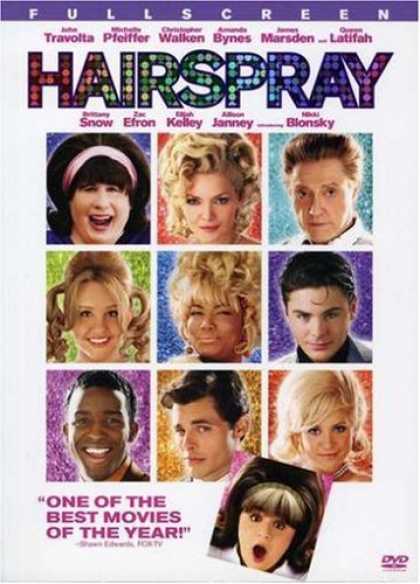Dir. Adam Shankman
Starring: Nikki Blonsky, John Travolta, Michelle Pfeiffer,
Christopher Walken
And so from a John Waters film to
a film based on a Broadway musical that is itself based on a John Waters film.
With a cry of “Good Morning Baltimore!” we are
introduced to Tracy Turnblad (a brilliant debut from Nikki Blonsky). It is 1962 and she lives for just
one thing: the music and dancing on TV’s The
Corny Collins Show. When the show announces that it is looking for a new
dancer Tracy is determined to apply. The only problem is, she’s not the usual
teenage pin up. She’s, well, almost as big as her beehive. And this is an era
in which conformity is prized. Anyone different, be they Tracy with her extra
baggage or Motormouth Maybelle (Queen Latifah), host of the monthly ‘negro day’, is seen as a threat by station
producer Velma Von Tussle (Michelle Pfeiffer, now all grown up from her
previous appearance, in Scarface).
The film, then, is – true to
Waters’ vision – about not being afraid to be different. Tracy and her even
larger mother Edna (played by John Travolta) find acceptance and self-belief.
More inspiring is the move towards integration of the black community, whether
it is the ending of segregated TV broadcasts or the budding romance between
Seaweed (Elijah Kelley) and Penny (Amanda Bynes). The candlelit march to the TV
station to the tune of 'I Know Where I’ve Been’
is the emotional core of the film, and is moving. In this, really only Velma, the
police / security guards, the news networks that exaggerate Tracy’s brush with
the law and Penny’s straitlaced and fundamentalist mother (The West Wing’s Allison Janney) are the bad guys. Even Velma’s
daughter Amber (Brittany Snow) turns away from her mother at the film’s end.
The TV show’s sponsor is willing to bend once he sees the way the wind is
blowing and heart-throb Link (Zac Efron) looks out for his career and then
regrets abandoning Tracy when she does the right thing. In comparison her
joke-shop owning father (Christopher Walken) loves Edna whatever she looks
like, as he expresses in the song ‘You’re
Timeless to Me’. Corny Collins is an enthusiastic integrationist and
Maybelle is colour-blind. And, as the end shows, the viewing teenaged audience
have no racial prejudice.
Okay, so the film shoots into an
open goal. So what? It has a period setting for a reason – in the ‘60s there
was a divide between black and white, and a lot of people supported that. Today
the storyline is not shocking. In fact, Tracy is not even particularly fat; she
is big-boned rather than obese. And the conceit of having Tracy’s mother being
played by a man isn’t shocking either. In Water’s 1986 original drag-queen
Divine played the role; 21 years later and it is Hollywood star John Travolta.
The portrayal is not particularly controversial: Travolta plays Edna like a
pantomime dame. If you’re British you will have seen something similar by your
sixth Christmas. Still, he seems to be enjoying himself in women's dress (perhaps not surprisingly if one believes current news stories...). But the basic storyline and the central themes is still mostly
that of Waters. Baltimore is seen as a haven of individuality, from the beehive
hairdos to Wilbur’s Hardy Har Hut to
the eccentric characters Tracy sees on her way to school (one of whom, “the flasher who lives down the street”,
was played by Waters; the woman he exposes himself to is his long-time
collaborator Mink Stole, who played Sylvia Mallory in Cecil B. Demented and Tammy in the original Hairspray). Other cameos from the original film include Jerry
Stiller (Ben’s dad) who was the original Wilbur and now appears as Mr Pinky and
Ricki Lake, the original Tracy (and who also appeared as Libby in Cecil B.) appears as a talent agent.
 |
| Not so Divine: Travolta makes it big on the main drag |
What have I learnt about
Maryland?
Again with the seafood! Velma is
a former ‘Miss Baltimore Crabs’. The
initial shot shows Baltimore as a harbour city so maybe that’s no surprise.
Baltimore also seems to be a city of terraced housing with corner-shops
populated by eccentrics and individualists. The locals call each other “hon”. A lot.
But most of all it depicts Maryland
as a Southern state with open racial segregation and discrimination (interracial marriage was
actually illegal in Maryland until 1967, so I hope Seaweed and Penny were not
planning on settling down too quickly).
Can we go there?
Like the original John Waters films, the
setting is Baltimore. However only the first establishing shot of the city by the bay
actually was Baltimore. The rest was Toronto and Hamilton in Canada. The
intersection of Dundas Street West and Roncesvalles Avenue in Toronto was used
for many of the street scenes. Lord Lansdowne Public School was used for all school exteriors and some
interiors, with the remainder being shot at Hamilton’s Queen Victoria School.
Other scenes took place on sets at Showline Studios.
Overall Rating: 4/5

No comments:
Post a Comment